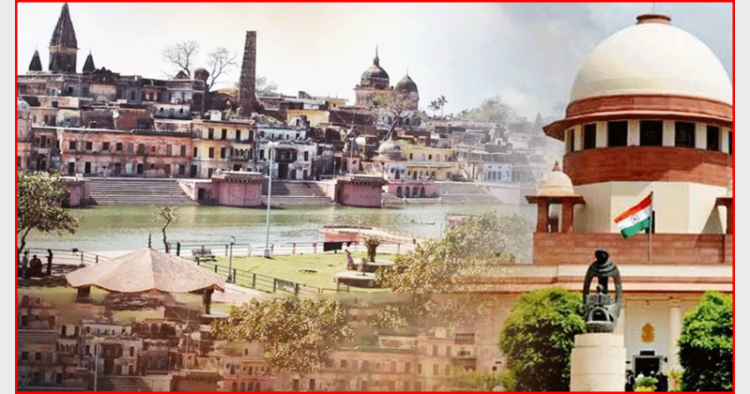
To the North-East of that spot is the place of the birth of Rama. This holy spot of the birth is the means of achieving salvation etc. It is said that the place of the birth is situated to the East of Vighneswar, to the North of Vasistha and to the West of Laumasa. Only by visiting it a man can get rid of staying (frequently) in womb (i.e. rebirth). There is no necessity for making charitable gifts, performing a penance or sacrifices or undertake pilgrimage to holy spots. On the Navami day the man should observe the Holy vow. By the power of the holy bath and charitable gifts, he is liberated from the bondage of births. By visiting the place of birth, one attains that benefit which is obtained by one who gives thousands of tawny-coloured cows every day. By seeing the place of birth, one attains the merit of ascetics performing penance in hermitage, of thousands of Rajasuya sacrifices and Agnihotra sacrifices performed every year” – Srimad Skandapuranam II.VIII.10.18-25
Ram Lalla finally reclaimed the Janmabhoomi on November 9, 2019 and the fight of His devotees for 491 years of struggle came to end with a decisive verdict by the five-member Constitution bench of the Supreme Court led by the Chief Justice of India. Though there are some divisive voices who continue to play their communal card for political gains, by and large the entire Bharat has accepted the verdict with utmost joy and contentment. ‘Not victory or defeat for any community’ was the overall narrative on the historic day. If legally, Ram Lalla Virajman won the case, why is it that nobody got defeated in actual sense? We need to get into the roots of this Iconic issue and the judgement to get the answer.
For the proponents of Temple, Shri Ram Janmabhoomi was never a Hindu-Muslim dispute. The invasion of Babar as explained by Guru Nanak Dev Ji, did not spare anybody, irrespective of caste, gender and religion. (Bringing the marriage party of sin, Babar has invaded from Kaabul, demanding our land as his wedding gift, O Lalo. Modesty and righteousness both have vanished, and falsehood struts around like a leader, O Lalo. The Qazis and the Brahmins have lost their roles, and Satan now conducts the marriage rites, O Lalo. The Muslim women read the Koran, and in their misery, they call upon God, O Lalo. The Hindu women of high social status, and others of lowly status as well, are put into the same category, O Lalo. The wedding songs of murder are sung, O Nanak, and blood is sprinkled instead of saffron, O Lalo. – Babar Bani, Pg 722-23). Since 1528, there have been 76 battles to reclaim the Janmabhoomi, not just for a place of worship but also for a symbol of our national icon, whose birthplace was attacked by the invaders. Shri Ram was not just considered as avatara (incarnation) of Bhagwan Vishnu but an icon of Bharatiya civilisation as the Maryada Purushottam. All Bharatiyas irrespective of the way of worship should associate with his avatar and message; this was the crux of the struggle.
Purely on the legal ground with the support of Travelogues, Gazetteers, the documentary record pertaining to the genesis of and the course which the disputes over the site in question followed; and documentary material pertaining to the use of the three domed structure found in the archaeological excavation, the judgement was delivered unanimously. Even the 2010 judgement of the Allahabad Bench of High Court upheld the case in favour of Shri Ram Lalla; the major difference that the SC has held that the three-way bifurcation by the High Court was legally unsustainable. This unanimity and clarity of the judgement is also iconic, considering the nature of the suit, where court has addressed all the issues from the modern tenets of legality spreading over the four period of history; starting from the ‘Skanda Purana’ to the present day legal provisions, without dealing with it as purely matter of religious faith or belief. The oral and scriptural history of Bharat has got the renewed sanctity through this judgement.
The concept of deity being a juridical entity, with specific nature and form, is a unique Bharatiya legal concept. The Pran Pratistha of the deity, the customs involved and also the nature of ownership of property also has a great deal of bearing on the legal interpretation. The case of Ram Lalla was fought by the close friends on his behalf, not to defeat somebody, but to reclaim the Janmabhoomi for Ram Lalla. It is a great chance for everyone to reconnect with great Icon of our civilisation for establishing Ram Rajya – ensuring prosperity, celebrating diversity and still, realising inherent spirituality. This will be a real victory of Bharat and true tribute to the milliions who fought various battles for reclaiming the birth place of Ram Lalla.
@PrafullaKetkar













Comments